Antonymy+2
Antonymy
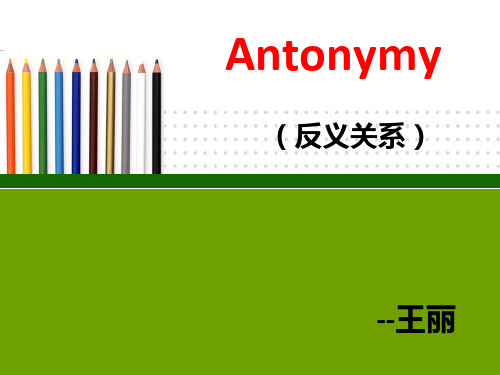
b converse
gradable
Thank you !!
Gradable antonymy(等级反义关系)
• This is the commonest type of antonymy . They are mainly adjectives .Just like go od:bad , long:short,big:small. And they h ave three characteristics . • 等级反义关系是反义关系最普遍的一种类型,他们 大多数都是形容词,例如:好与坏,长和短,大和 小。这类词有三个特点。
Antonymy
(反义关系)
--王丽
Antonymy is the name for oppositene ss relation. There are three sub-types: gradable, complementary and convers e antonymy 反义关系是对立关系的专业术语,它包括三 个此类: 等级反义关系,互补反义关系和反 向反义关系。
三者之间的比较
• 总体来说,等级反义关系和互补反义关系有一个共同点, 那就是只存在于一个实体,而反向反义关系必须包含两个 实体,而且彼此互为前提。除此,等级反义关系的三个特 点和互补反义关系的三个特点完全对立。但二者却都和反 向反义关系有或多或少的相似之处。
a
b
a b
complementa ry
a
(2)绝对性 互补反义关系的标准是绝对的,无论该类中的词以哪 个标准评判都产生同样的效果。例如:dead一词,一 个人死了,以人类评判标准,这个人是死的;以动物 的评判标准,这个人还是死的,不可能因为评判标准 的不同,死人就可以变成活人
《Antonymy总结》课件

Antonymy在语言学研究中的地位和作用
地位
反义词是语言学研究中的重要概念之一,是 词汇语义关系的重要组成部分。反义词的辨 析和研究有助于深入理解语言的本质和结构 ,推动语言学的发展。
作用
反义词在语言学研究中具有多种作用,如词 汇语义对比、语言演变研究、语言习得和教 育等。通过对反义词的研究,可以更深入地 了解语言的内部机制和规律,为语言学研究
和应用提供有力支持。
Antonymy在未来的应用前景
随着自然语言处理技术的不断发展,反义词的应用前景将更加广阔。例如,在机 器翻译中,通过对反义词的辨析和应用,可以提高翻译的准确性和流畅性。在语 义分析和文本生成中,反义词的应用也有助于提高文本的质量和自然度。
此外,反义词的研究和应用也有助于提高语言习得和教育水平。通过对反义词的 辨析和对比,可以帮助学习者更好地掌握词汇的意义和使用,提高语言表达能力 。同时,反义词的应用也可以丰富教育手段和资源,提高教育效果和质量。
挑战
随着语言的发展和变化,反义词的边界和意 义也在不断演变,需要不断更新和修正研究 方法。同时,反义词的语义关系和用法也需 要深入探究,以更全面地理解其本质。
机遇
随着语言学理论和方法的不断进步,反义词 的研究将更加深入和全面。同时,随着自然 语言处理技术的发展,反义词的应用前景也 将更加广阔,如机器翻译、语义分析和文本 生成等领域。
详细描述
Antonymy是指两个或多个词具有相反或相对的意义关系。它是语言学中的一 种重要概念,对于理解词汇关系和语言结构具有重要意义。
Antonymy的起源和历史
总结词
起源与演变
详细描述
Antonymy起源于古希腊和拉丁语的词汇对比,随着语言的发展而逐渐丰富。在 英语中,Antonymy主要表现在同义词和反义词之间,是词汇关系中的重要组成 部分。
Antonymy总结

Ⅱ、Complementary antonyms
互补反义词
Means the members of a pair in this type are complemtary to each other.
They divide up the whole of a semantic field语义场 completely.
⊕alive—dead
⊕male—female
⊕present—absent ⊕odd奇—even偶 ⊕hit—miss(a target) ⊕same—different
⊕innocent—guilty ⊕pass—fail (a test) ⊕boy—girl
excellent good bad
terrible
The denial of one is not
necessarily the assertion of the
other.
We often say but there are also
cold—hot
chilly, cool, lukewarm微温 的,warm
young—old mature ,middle-aged, elderly
beautiful—ugly good-looking好看的, plain
rich—poor
well-to-do小康的 ,moderately
wealthy,comfortably off相当富
有的
big—small
quite big, medium-sized, quite small, tiny
单词之间的语义关系

单词之间的语义关系单词之间的语义关系是指它们在意义上的相互关联。
以下是几种常见的语义关系:1.同义关系(Synonymy):两个单词具有相同或相似的意义。
例如,"happy"(快乐)和"joyful"(愉快的)是同义词。
2.反义关系(Antonymy):两个单词具有相反的意义。
例如,"hot"(热的)和"cold"(冷的)是反义词。
3.上下位关系(Hyponymy/Hypernymy):一个单词是另一个单词的特殊情况或更一般的概念。
例如,"rose"(玫瑰)是"flower"(花)的下位词,而"flower"是"rose"的上位词。
4.同源关系(Hyponymy):两个单词有着相同的词根或来源。
例如,"teach"(教)和"teacher"(教师)之间有同源关系。
5.部分-整体关系(Part-Whole Relationship):一个单词表示另一个单词的一部分或组成部分。
例如,"wheel"(轮子)是"car"(汽车)的一部分。
6.同位关系(Co-hyponymy):两个单词都是同一个更一般的概念的子类。
例如,"lion"(狮子)和"tiger"(老虎)都是"big cats"(大型猫科动物)的同位词。
7.概括关系(Holonymy/Meronymy):一个单词表示另一个单词的整体或包含关系。
例如,"book"(书)是"page"(页)的整体。
这些语义关系帮助我们理解单词之间的联系,拓展我们的词汇量,并提供了更丰富的语言表达能力。
在自然语言处理和语义分析领域,理解和利用这些语义关系对于词义消歧、信息检索和语义推理等任务非常重要。
antonym的用法总结大全
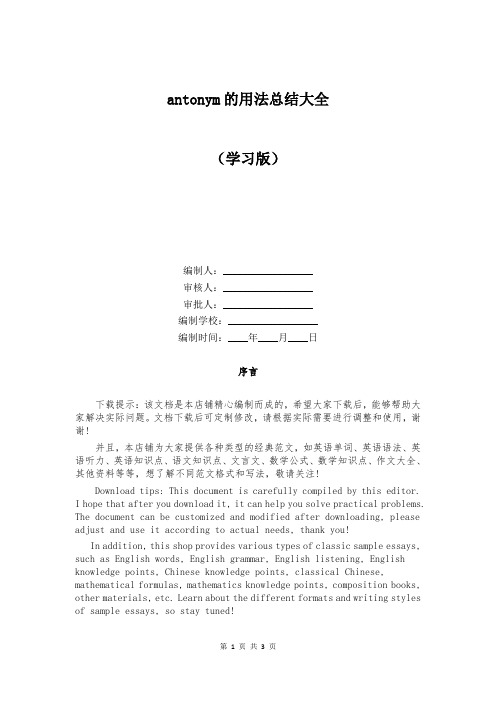
antonym的用法总结大全(学习版)编制人:__________________审核人:__________________审批人:__________________编制学校:__________________编制时间:____年____月____日序言下载提示:该文档是本店铺精心编制而成的,希望大家下载后,能够帮助大家解决实际问题。
文档下载后可定制修改,请根据实际需要进行调整和使用,谢谢!并且,本店铺为大家提供各种类型的经典范文,如英语单词、英语语法、英语听力、英语知识点、语文知识点、文言文、数学公式、数学知识点、作文大全、其他资料等等,想了解不同范文格式和写法,敬请关注!Download tips: This document is carefully compiled by this editor.I hope that after you download it, it can help you solve practical problems. The document can be customized and modified after downloading, please adjust and use it according to actual needs, thank you!In addition, this shop provides various types of classic sample essays, such as English words, English grammar, English listening, English knowledge points, Chinese knowledge points, classical Chinese, mathematical formulas, mathematics knowledge points, composition books, other materials, etc. Learn about the different formats and writing styles of sample essays, so stay tuned!antonym的用法总结大全antonym的意思antonym的简明意思n. 反义词英式发音 ['æntənɪm] 美式发音 ['æntənɪm]antonym的词态变化为:形容词: antonymic 名词: antonymyantonym的具体用法如:Love and hate are antonyms.爱和恨是反义词.在此句中antonym表示反义词的意思antonym的用法例句In these antonyms adjective and verb is more than obviously noun and other part of speech.这些反义词中形容词和动词明显多于名词和其它词类.在此句中antonym表示反义词的意思A problem occurred obtaining synonyms, antonyms, related words, or related phrases list.在获取同义词、反义词、关联词或关联词组列表时发生问题.在此句中antonym表示反义词的意思Good'is the antonym of'bad '.“好”是“坏”的反义词.在此句中antonym表示反义词的意思T : Yes , what is the antonym of " interesting '? "那它的反义词是哪一个呢 ?在此句中antonym表示反义词的意思A word which has more than one meaning can have more than antonym.一个词有多种含义,有其相对应的反义词.在此句中antonym表示反义词的意思。
(Antonymy) 反义词

Type 3: Converse antonym(相对反义词/关系反义词)
Converse display a type of oppositeness of meaning, also called relational opposites, find especially in words concerning reciprocal social roles, spatial relational
popular-nonpopular
(3) Words which are polysemantic can have more than one antonym.
dull-interesting, amusing, entertaining
dull-clever, bright,caple
dull-active
➢ Spring, Summer, Autumn, Winter; January, February…December; Sunday, Monday…Saturday;…
Antonyms classified on the basis of the morphological structure
• Contrary term show a type of oppositeness of meaning ,illustrated by such pairs as wide/narrow,old/young,big/small ,etc.
• Gradability(by Sapir) means that contraries can be placed at both extreme of a scale, between which there may be gradable lexical items.
英语语言学Chapter 5 Meaning

Leonard Bloomfield(1887-1949)
Bloomfieldian Age: 1933-1950
Behaviourism: stimulus-response reinforcement, stimulus-response
His formula for practical stimulus and speech stimulus:
❖ Reference (所指) : Reference means what a linguistic form refers to in the real, physical world; it deals with the relationship between the linguistic element and the nonlinguistic world of experience.
❖ The Conceptualist theory (概念论): The conceptualist
theory holds that there is no direct link between a linguistic form and what it refers to ; rather, in the interpretation of meaning, they are linked through the mediation of concepts in the mind, i. e. the meaning of a word is its concept. The notion “concept” is the semantic triangle proposed by Ogden and Richards in their The Meaning of Meaning.
英语词汇学——反义词
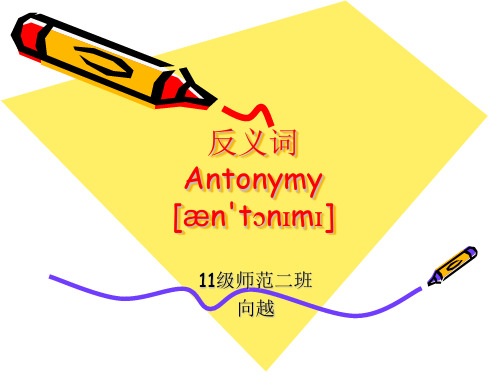
1、Gradable等级性
——the members of a pair differ in terms of degree. The denial of one is not necessarily the assertion of the other.
excellent good bad
terrible
(1)The assertion of one is the denial of the other 非此即彼
(2)Nongradable无等级性
1)The assertion of one is the denial of the other 非此即彼.
there is no middle ground between them.
• Verb
Love
hate
attachment liking indifference antipathy
依恋
喜欢 漠不关心 反感
Converse是什么?
匡 威? 鞋 子?
Converse 不仅仅是匡威
更是……
逆反反义词
III. Converses 逆反反义词
Two kinds
(1)Relational opposites关系反义词 (2)Reverse terms 逆反词
主观上Mary觉得房子更大了,因为住的 人少了。
3.Middle ground中间状态
• Adj.
old
middle-aged
open ajar半掩
rich
well-to-do小康
hot
warm
beautiful good-looking
young
close
poor
Antonymy

Antonymy班级:英语111 姓名:余舒敏学号:11021124In linguistics, antonymy is technical the name for oppositeness relation. Words that are opposite in meaning are antonyms. Antonymy can be adjectives, verbs and nouns. A word may have more than one antonym. And what surperize me is that there are three main sub-types: gradable antonymy, complementary antonymy, and converse antonymy.Gradable antonymy: As the name suggests, they are gradable. That is, the members of a pair in terms of degree. The denial of one is not necessarily the assertion of the other. There are often intermediate forms between the two members of a pair. And they are mainly adjectives. For instance, hot: cold are of this type. And the assertion of “hot” is not necessarily “cold”. It could be chilly, cool, warm and so on. Besides, gradable antonymy may have comparative and superlative degrees. For example, big: small (big-bigger-biggest; small-smaller-smallest). What’s more, gradable antonymy is being graded against different norms. Lastly, one member of a pair, usually the term for the higher degree, serves as the cover term. In other words, in general, it is the cover term that is more often used. For example, the word “old” in sentence “How old are you” not mean old, we can make it into “what is your age”. And in my opinion, the easy way to distinguish gradable words is to check intermediate words between two members of a pair as well as the contrary in meaning.Complementary antonymy: A pair of complementary antonyms is characterized by the feature that the denial of one member of the pair implies the assertion of the other. In other words, it is not a matter of degree between two extremes, but a matter of either one or the other. Different to gradable antonymy, the members of a pair in this type divide up the whole of a semantic field completely, and there are no intermediate words between two members of a pair. It’s just a question of YES or NO. That’s why the adjectives in this type cannot be modified by very. Besides, theseantonyms truly represent oppositeness of meaning. For instance, odd: even. All numbers can put into the odd or the even without exceptions.Converse antonymy: Pairs of words that exhibit the reversal of a relationship between the two items are called converse antonyms. This type of antonym is typically seen in reciprocal social roles, such as kinship relation, temporal or spatial relations. So they are also named relational opposites. And in my understanding, converse antonymy has one of the three following features: 1. Relational. It refers to those words indicate identity, such as husband and wife. 2. Spatial. It refers to those words indicate space such as left and right. 3. Reciprocal. Words have this feature are mainly verbs. And the actions that two members of a pair will be finished at the same time such as buy and sell. When someone buys something, someone else sells at the same time. We can distinguish it with a simple sentence “If A is the… of B, then B is the… of A”.Especially to deserve to be mentioned, antonyms of both sides is a semantic field, and the factors that form a semantic field are national way of thinking, thinking habits, social awareness ,Language communication needs, the characteristics of the English language and so on. That is to say, a pair of antonyms in one language may not correct in other language, and there are some distinguishing aspects of antonyms in one language.。
英语专业词汇学Antonyms

---by Charles Dickens
4. lexical antonym is often stronger than syntactic negation.
6.4.3. Use of antonyms
Stylistic purpose of the use of antonyms
To achieve emphasis by putting contrasting ideas together, to express economically the opposite of a particular thought.
?worstwisdombeliefdarknessspringofhopenothingincouplets?矛盾联?大小姐洗黑白菜?高矮子吃热凉粉??假山真鹿走?死水活鱼游??穿冬装戴夏帽胡度春秋?走南方窜北方混帐东西王尔烈?船载货物货重船轻轻载重?尺量土地地长尺短短量长??北雁南飞双翅东西分上下?前车后辙两轮左右走高低??思前想后看左传书往右翻?坐北朝南吃西瓜皮向东甩antonymsinchineseidioms?theorderoftheantonyms?夫贵妻荣夫唱妇随男耕女织?善男信女痴男怨女男婚女嫁?男盗女娼男女有别男婚女嫁?君臣官民父母公婆父子祖孙?婆媳国家师生?胜负兴亡文武升降日月南北吉凶?厚薄年月前后东西好歹雅俗天地theinauguraladdressofpresidentkennedy?weobservetodaynotavictoryofpartybutacelebrationoffreedomsymbolizinganaswellasasignifyingaswellas?
1). Root antonyms 词根反义词 2). Derivational antonyms 派生反义词
英语专业词汇学Antonyms

互补反义词 Contraries 相对反义词 Conversives 逆反反义词
6.4 Antonymy
Contraries(相对反义词/两极反义词)
Gradable antonyms/opposites Antonyms of this type are best viewed in terms of a scale running between two poles or extremes.
Having particular implication
man author
woman authoress lioness
lion
She is the greatest author of the age. She is the greatest authoress of the age.
Features:
1. absolute contrast; mutually exclusive
The denial of one means the acceptation/assertion of the other or vice versa.
2. nongradable No comparative degree, not modified by adverbs 3. no intermediate terms
---by Charles Dickens
4. lexical antonym is often stronger than syntactic negation.
6.4.3. Use of antonyms
词汇学 反义关系

3) Converses 逆反反义词
Converses consist of relational opposites such as parent— child, husband—wife, predecessor—successor, employer— employee. The pairs of words indicate such a reciprocal social
2. Some of the Characteristics of Antonyms 反义词的 一些特点
Words denoting nature, quality or state of things have in many cases antonyms. This accounts for abundance of antonyms among adjectives. Next come verbs which denote action or activity. Least antonyms are found among nouns which generally denote names of objects, domain, idea, etc. 表示性质、品质和状态的词在许多情况下具有反义词。这说明 了形容词中反义词多的原因。下一类是表示行动和行为的动词。 一般表示物体名称、领域名称和思想名称的名词中反义词最少。
true — false,
same — different
perfect — imperfect, single — married
chapter 6(2) antonymy,hyponymy and taxonymy
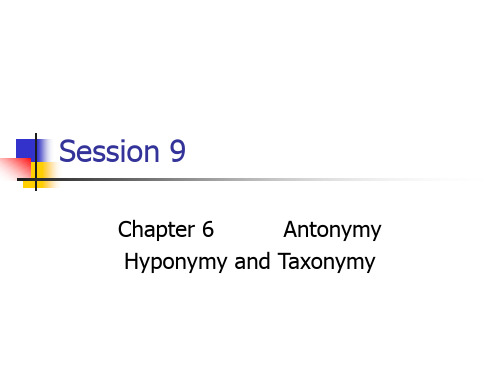
This type also includes reverse terms, which comprise adjectives and adverbs signifying a quality, or verbs and nouns signifying an act or state that reverse the quality, action or state of the other.
meaning
c ) Some words can have two different types of antonyms at the same time, one being the negative and the other opposite, e. g.
happy/ unhappy/ sad, productive/ unproductive / destructive free /unfree / enslaved
hot warm
中点
cool cold
good --- bad:
excellent-good-bad-terrible
wet --- dry:
wet-moist-dampish-dry
Features of contrary antonyms:
1)The two opposites are gradable and one exists in comparison with the other.
(2) Another distinctive feature of this category is that such antonyms are non-gradable. They cannot be used in comparative degrees and do not allow adverbs of intensity like very to qualify them. Take single/married for example. If someone is single, s/he cannot be married. It is incorrect to say ‘S/He is very single, or more single, or extremely single.’
antonyms的三种类型及其例子
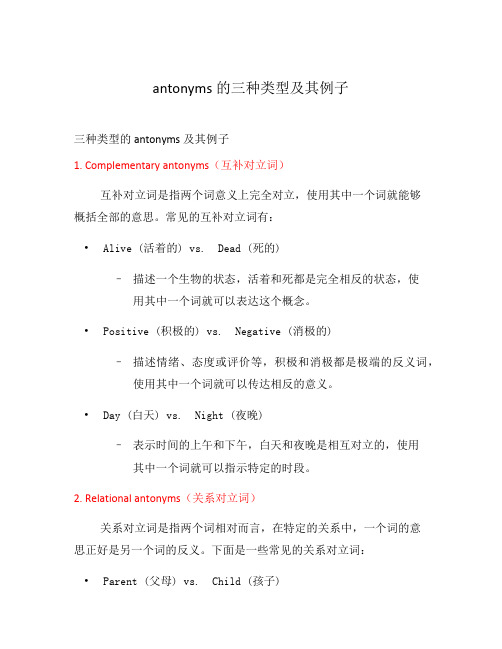
antonyms的三种类型及其例子三种类型的antonyms及其例子1. Complementary antonyms(互补对立词)互补对立词是指两个词意义上完全对立,使用其中一个词就能够概括全部的意思。
常见的互补对立词有:•Alive (活着的) vs. Dead (死的)–描述一个生物的状态,活着和死都是完全相反的状态,使用其中一个词就可以表达这个概念。
•Positive (积极的) vs. Negative (消极的)–描述情绪、态度或评价等,积极和消极都是极端的反义词,使用其中一个词就可以传达相反的意义。
•Day (白天) vs. Night (夜晚)–表示时间的上午和下午,白天和夜晚是相互对立的,使用其中一个词就可以指示特定的时段。
2. Relational antonyms(关系对立词)关系对立词是指两个词相对而言,在特定的关系中,一个词的意思正好是另一个词的反义。
下面是一些常见的关系对立词:•Parent (父母) vs. Child (孩子)–表示亲属关系,父母与孩子是一种特殊的关系,一个是另一个的反义。
•Buy (买) vs. Sell (卖)–在商业交易中,买和卖是相对的概念,进行买卖时使用其中的一个词表示特定的行为。
•Above (在…之上) vs. Below (在…之下)–在空间位置中,存在上下的相对关系,上方和下方就是在空间中互为对立的词语。
3. Gradable antonyms(可分级对立词)可分级对立词是指两个完全对立的词之间存在多个中间状态,可以通过不同的程度来表示。
以下是几个例子:•Tall (高的) vs. Short (矮的)–高和矮是相对的概念,人的身高可以有多种不同的程度,可以使用不同的形容词来表示。
•Hot (热的) vs. Cold (冷的)–热和冷也是相对的,温度可以有很多个级别,所以使用不同的词来表达这种温度变化。
•Young (年轻的) vs. Old (年老的)–年龄也是一个可分级的概念,人可以在不同的年龄阶段,年轻与年老是互为对立的词语。
antonyms的三种类型及其例子
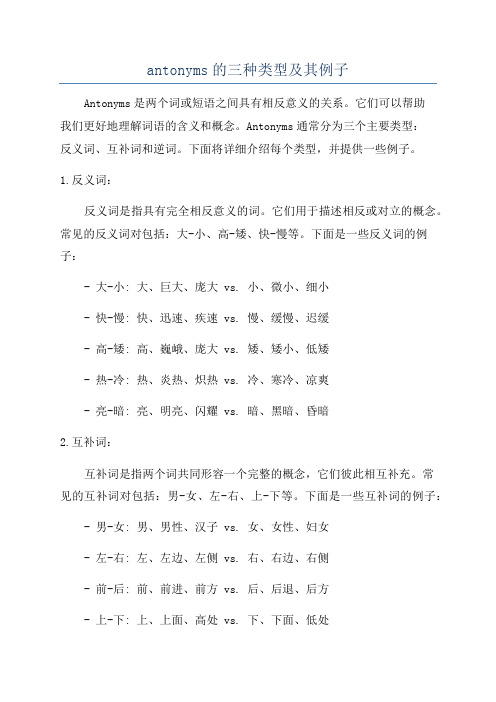
antonyms的三种类型及其例子Antonyms是两个词或短语之间具有相反意义的关系。
它们可以帮助我们更好地理解词语的含义和概念。
Antonyms通常分为三个主要类型:反义词、互补词和逆词。
下面将详细介绍每个类型,并提供一些例子。
1.反义词:反义词是指具有完全相反意义的词。
它们用于描述相反或对立的概念。
常见的反义词对包括:大-小、高-矮、快-慢等。
下面是一些反义词的例子:- 大-小: 大、巨大、庞大 vs. 小、微小、细小- 快-慢: 快、迅速、疾速 vs. 慢、缓慢、迟缓- 高-矮: 高、巍峨、庞大 vs. 矮、矮小、低矮- 热-冷: 热、炎热、炽热 vs. 冷、寒冷、凉爽- 亮-暗: 亮、明亮、闪耀 vs. 暗、黑暗、昏暗2.互补词:互补词是指两个词共同形容一个完整的概念,它们彼此相互补充。
常见的互补词对包括:男-女、左-右、上-下等。
下面是一些互补词的例子:- 男-女: 男、男性、汉子 vs. 女、女性、妇女- 左-右: 左、左边、左侧 vs. 右、右边、右侧- 前-后: 前、前进、前方 vs. 后、后退、后方- 上-下: 上、上面、高处 vs. 下、下面、低处- 开-关: 开、打开、启动 vs. 关、关闭、停止3.逆词:逆词指的是在程度、方向或行动意图上相互相反的词。
它们描述的是一个概念的相反状态。
常见的逆词对包括:增加-减少、进-出、赞成-反对等。
以下是一些逆词的例子:- 增加-减少: 增加、增长、扩大 vs. 减少、减小、缩小- 进-出: 进、进入、前进 vs. 出、出去、退后- 赞成-反对: 赞成、支持、同意 vs. 反对、反对、不同意- 上升-下降: 上升、上升、增加 vs. 下降、下降、减少- 好-坏: 好、优秀、出色 vs. 坏、糟糕、不好需要注意的是,有时候一个词既可以作为反义词也可以作为逆词,具体取决于上下文和语境。
例如,“好”既可以是“坏”的反义词,也可以是“坏”的逆词,具体取决于使用场景。
antonyms的三种类型及其例子

antonyms的三种类型及其例子类型一:反义词对立反义词对立是最常见的一种反义关系类型,即两个词在语义上完全对立,有相反的意义。
这些反义词通常在词义和用法上都有一定的差异,并且在词汇中具有相对的地位。
以下是一些反义词对立的例子:1.大小:大-小例句:这本书很大,那本书很小。
2.高矮:高-矮例句:他比我高一点,但比他的弟弟矮。
3.厚薄:厚-薄例句:这件衣服很厚,那件衣服很薄。
4.轻重:轻-重例句:这个箱子很轻,那个箱子很重。
5.快慢:快-慢例句:她跑得很快,他跑得很慢。
类型二:层级反义词层级反义词是指在同一个概念范畴中,表示不同程度、强度或数量的两个词。
一个词表示较高程度或数量,另一个词表示较低程度或数量。
以下是一些层级反义词的例子:1.高低:高-低例句:海拔高的地方气温较低。
2.年长:年长-年轻例句:他的姐姐比他年长五岁,他的弟弟比他年轻三岁。
3.浓淡:浓-淡例句:这杯茶太浓,用水稀释一下变得更淡些。
4.多少:多-少例句:这个城市有很多人口,而乡村地区的人口少。
5.忙碌:忙-闲例句:工作日他很忙,但周末他比较闲。
类型三:逆序反义词逆序反义词是指两个词通过改变或反转其中一种性质、方向或状态,表达相反的含义。
这种反义关系常常用于表示转换、否定、否认等概念。
以下是一些逆序反义词的例子:1.开关:开-关例句:请把门打开,别把门关上。
2.收放:收-放例句:下雨了,请把洗好的衣服收回来。
3.增减:增-减例句:今年的销售额增长了10%,比去年增加了很多。
4.进退:进-退例句:需要进一步推进,不能停滞不前。
5.接收:接-放例句:我将接收他的工作,他则可以放松一下。
总结起来,反义关系可分为反义词对立、层级反义词和逆序反义词三种类型。
反义词对立的反义关系最为明显,两个词在意义上完全相反;层级反义词表示同一个概念中两个词的不同程度或数量;逆序反义词通过改变其中一种性质、方向或状态,表达相反的含义。
这些不同类型的反义关系在我们的日常交流和写作中起着重要的作用,能够丰富我们的词汇选择,使语言更加灵活多样。
antonyms的三种类型及其例子(一)
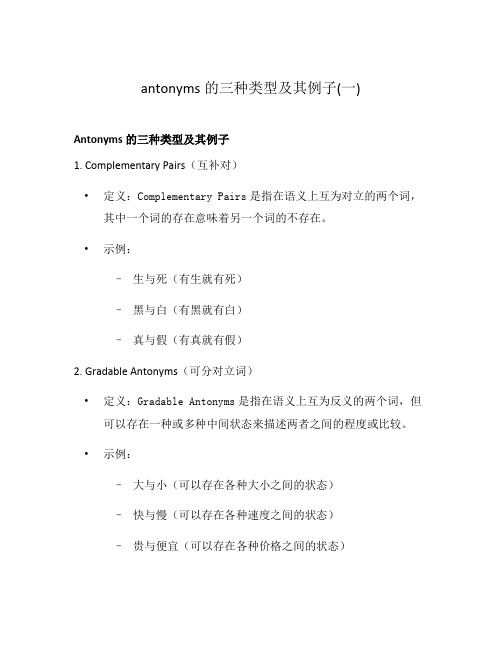
antonyms的三种类型及其例子(一)Antonyms的三种类型及其例子1. Complementary Pairs(互补对)•定义:Complementary Pairs是指在语义上互为对立的两个词,其中一个词的存在意味着另一个词的不存在。
•示例:–生与死(有生就有死)–黑与白(有黑就有白)–真与假(有真就有假)2. Gradable Antonyms(可分对立词)•定义:Gradable Antonyms是指在语义上互为反义的两个词,但可以存在一种或多种中间状态来描述两者之间的程度或比较。
•示例:–大与小(可以存在各种大小之间的状态)–快与慢(可以存在各种速度之间的状态)–贵与便宜(可以存在各种价格之间的状态)3. Relational Opposites(关系反义词)•定义:Relational Opposites是指在语义上互为反义的两个词,它们的关系是建立在某种关联或依赖上的。
•示例:–父与子(父亲和儿子是互为反义词,它们的关系是建立在亲子关系上的)–雇主与雇员(雇主和雇员是互为反义词,它们的关系是建立在雇佣关系上的)–教师与学生(教师和学生是互为反义词,它们的关系是建立在教学关系上的)注意:以上只是对不同类型antonyms的简单解释和例子。
实际上,antonyms在语言中的种类非常丰富多样,每个语言都可能存在自己独特的antonyms类型。
补充说明在语言中,antonyms(反义词)是指具有相反意义的词语。
对于同一个概念或语义范畴,存在两个相对立的词语,它们通过意义上的对立来传达不同的信息。
下面继续介绍antonyms的一些补充说明和例子。
1. Complementary Pairs(互补对)在Complementary Pairs中,两个词的意义是完全相反的,其中一个词的存在意味着另一个词的不存在。
例如,生与死是互补对,有生就有死,没有生就没有死;黑与白也是互补对,有黑就有白,没有黑就没有白;真与假是另一个常见的互补对,有真就有假,没有真就没有假。
2015中考语文初中常见知识点之反义词
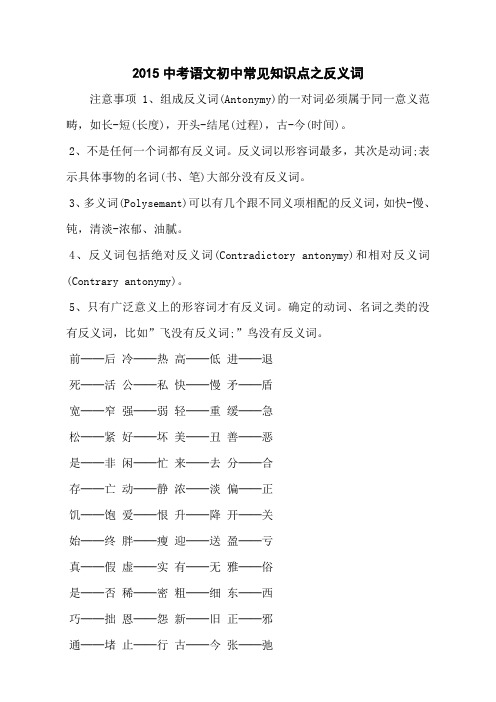
2015中考语文初中常见知识点之反义词注意事项1、组成反义词(Antonymy)的一对词必须属于同一意义范畴,如长-短(长度),开头-结尾(过程),古-今(时间)。
2、不是任何一个词都有反义词。
反义词以形容词最多,其次是动词;表示具体事物的名词(书、笔)大部分没有反义词。
3、多义词(Polysemant)可以有几个跟不同义项相配的反义词,如快-慢、钝,清淡-浓郁、油腻。
4、反义词包括绝对反义词(Contradictory antonymy)和相对反义词(Contrary antonymy)。
5、只有广泛意义上的形容词才有反义词。
确定的动词、名词之类的没有反义词,比如”飞没有反义词;”鸟没有反义词。
前──后冷──热高──低进──退
死──活公──私快──慢矛──盾
宽──窄强──弱轻──重缓──急
松──紧好──坏美──丑善──恶
是──非闲──忙来──去分──合
存──亡动──静浓──淡偏──正
饥──饱爱──恨升──降开──关
始──终胖──瘦迎──送盈──亏
真──假虚──实有──无雅──俗
是──否稀──密粗──细东──西
巧──拙恩──怨新──旧正──邪
通──堵止──行古──今张──弛。
- 1、下载文档前请自行甄别文档内容的完整性,平台不提供额外的编辑、内容补充、找答案等附加服务。
- 2、"仅部分预览"的文档,不可在线预览部分如存在完整性等问题,可反馈申请退款(可完整预览的文档不适用该条件!)。
- 3、如文档侵犯您的权益,请联系客服反馈,我们会尽快为您处理(人工客服工作时间:9:00-18:30)。
contents
Explanation Types
of antonyms
Characteristics
of
antonyms
What is Antonymy?
Antonymys are words with oppsite or nearly oppsite meanings.
sell vs. buy teacher vs.student husband vs. wife man vs. woman parent vs. child The two sides formed a unity of opposites (a unity of opposite)对立统一体
Characteristics of antonyms
Semantic circumscription of antonyms(语义包孕 性)
In a set of opposites, one is our commonly used, called unmarked. Another is not commonly used, we called marked.
it is ca lle d re la tionship a ntonym s A ntonym s w ith opposite fe a ture s m ostly involve socia l re la tions a nd spa tia l re la tionships ,
Eg : guest vs. host
Characteristics of antonyms
Ambiguity(模糊性)
Extension of the concept of the word refers to expressed no clear boundaries. The ambiguity of the word means that extension of the concept of the word have no clear boundaries. Eg: young vs. old dawn vs. morning afternoon vs. evening big vs. small high vs. low far vs. near, wide vs. narrow light vs. heavy
Eg:
beautiful-pretty- good-looking-plain-ugly
love-attachment依恋- like- indifference- antipathy 反感- hate
Characteristics of antonyms
Complementary (互补性)
Eg: The snake, however continued to ‘dance’ slowly. It is obviously that it could not tell the differences between Indian music and Jazz. In fact ,Indian music and Jazz do not have any contraries, but in this sentence, they are antonyms to each other(印度音乐和爵士乐一个代表东方音乐,一个代表西方音 乐).
Cold (寒冷 的) Hot (炎热的) Cool (凉 爽的) Warm(温 和的) Rich (富 裕的) Poor(贫 穷的) destitute(贫 困的) Their position can not be exchanged opulent( 富足的)
Characteristics of antonyms
Types of antonyms
(2) Semantic classification 1) Contraries 2) Complementaries
3) Conversives
Characteristics of antonyms
Relativity (相对性) One of them is compared with the other so that they can exist. These two opposites can not be established without the respective comparison.
Characteristics of antonyms
For example: “ tall, old, big” are marked words, “ short, young, small” are unmarked. So we often use “How old are you?” instead of “How young are you?” “There has been no man on the island“,in this sentence,man includes woman,they are not opposite。
For example:In some occasion, rise and decline are antonyms. The prices are declining.The prices are rising. However , the health is declining.(improving)
Characteristics of antonyms
Flexibility(灵活性)
The corresponding relationship of Antonyms is relatively, not absolutely。 反义词的对立关系不是机械地、简单地一对一的关系, 而是有着一定的灵活性。
Eg:man-woman,live-die,single-married If Tom is not married, he is single; if he is not single,he is married.
Characteristics of antonyms
Contrary (opposition) (对立性)
Conditionality in context (反义词的语境制约 性)
Some words appear in some occasions is opposite to each other, but on another occasion, they are not antonyms for each other.
Differency (差异性)
Every relative antonym have their corresponding antonym, and varies with the degree of intensity
Eg: hot and warm are Synonyms, but the intensity is different. Thus, they have different antonyms.
Types of antonyms
There are two types of antonyms according to morphology and semantics:
(1) Morphologocal classification 1) Root antonyms clear—— vague large—— small 2) Derivative antonyms pleasant—— unpleasant polite—— impolite formal—— informal
Characteristics of antonyms
Gradability (渐进性)
Intermediate polar of opposites can inserte words that represent different degrees of words, reflecting the level层次 of opposition Words which represent different degrees of nature
This kind of antonyms are usually only composed of two words with mutually exclusive互相排斥 meaning. it also cannot be compare, nor is modified by degree adverbs (very).The characteristic of it is that the denial of one means the assertion of the other or vice versa.
Eg: “Are the workers free or enslaved?” (工人们是自由的还是受奴役的?) “Is the translation free or literal?” (译文是意译还是直译的?) “Are the tickets free?Or:Do you have to pay for them?”
Characteristics of antonyms
Vacancy (空位性)
Though English vocabulary is very rich, but some vocabulary which have the antonymy relationship do not have the antonyms, which lead to the vacancy of antonyms. Free has many meanings ,most of the word meaning are have the antonyms.But when free as meaning for 免费, there was none antonyms
